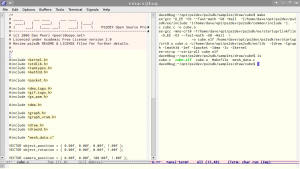Once you have a system for running unauthorised code, you can test it with some well used homebrew – I used uLaunchElf for this purpose. Using swapmagic you need to put the executable on your usb stick called SWAPMAGIC/SWAPMAGIC.ELF and it should boot automatically. Not all usb sticks work, I had to try a few before I found a suitable one.
The next task is installing the toolchain of compilers and related utilities for making your own executables. At this point I found that the ps2dev site was offline along with it’s svn repo, but I managed to find a backup here, which I am now mirroring here. When you have the svn repo recreated, follow the instructions in ps2dev/trunk/ps2toolchain/readme.txt to build and install, you just need to set up some paths to tell it where to install (I use ~/opt) and run a script. The script tries to update from the unresponsive official svn, so I also had to change ps2toolchain/scripts/005-ps2sdk.sh to get it to complete.
You get a load of sample code in ps2dev/ps2sdk/samples, all you need to do is run make to build them. Just as with the Nintendo DS and Android devices, the compiler is gcc – or rather “ee-gcc”. “ee” stands for the Emotion Engine, Sony’s name for the main MIPS processor.
The result of the make command in the exciting screenshot above is a file called “cube.elf”. ELF stands for Executable and Linkable Format, a unix standard (debugging variants used to be called DWARFs “Debugging With Attributed Record Formats”, I make no comment).
Copy this to your USB stick and you should see something like this:


Leave a Reply to dave Cancel reply